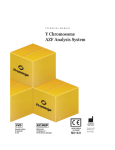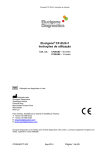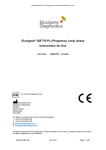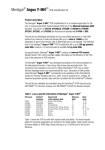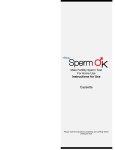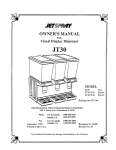Download GB - Elucigene
Transcript
Elucigene® Male Factor Infertility Products Instructions for Use Elucigene® Male Factor Infertility Products Instructions for Use Product Elucigene Male Factor Infertility Elucigene MFI-Yplus Size 25 tests 10 tests Catalogue Code AZFXYB1 AZFPLBX For In-Vitro Diagnostic Use Manufactured by: Elucigene Diagnostics Citylabs Nelson Street Manchester M13 9NQ For Sales, Customer Service and Technical Support:T: +44 (0) 161 669 8122 F: +44 (0) 161 669 8129 E: [email protected] E: [email protected] Elucigene Diagnostics is the trading name of Delta Diagnostics (UK) Limited., a company registered in England and Wales, registration number 8696299. ANXYAZFEN 001 Jun-2015 Page 1 of 42 Elucigene® Male Factor Infertility Products Instructions for Use Elucigene Male Factor Infertility The Elucigene Male Factor Infertility range of products are DNA based multiplexed assays for the rapid determination of sex chromosome aneuploidy status and detection and characterisation of the three most common classes of Y chromosome microdeletion associated with male infertility. Elucigene Male Factor Infertility kits are available in the formats listed below. For more information on the kits in the Male Factor Infertility range please visit: http://www.elucigene.com/product-category/reproductive-health/ Intended Use Male Factor Infertility For the routine in-vitro quantitative diagnosis of the most common sex chromosome aneuploidies (e.g. Klinefelter syndrome) and Y chromosome microdeletions (AZFa, AZFb and AZFc) commonly associated with male factor infertility. The assay includes sex chromosome STR markers XHPRT and DXYS218 and non-STR markers AMEL, TAF9L and SRY markers for the determination of sex chromosome aneuploidy status. The assay also includes the Y specific markers sY84, sY86, sY127, sY134, sY254 and sY255 for the detection of Y chromosome microdeletions of the AZFa, AZFb and AZFc loci. The method employed by the Elucigene Male Factor Infertility kit is the QF-PCR (Quantitative Fluorescence-Polymerase Chain Reaction) technique. The devices are intended to be used on DNA extracted from whole blood (EDTA) and it is not intended for use with other test matrices. The intended target population are male patients with suspected infertility and who may be exhibiting associated features such as low sperm count. The device is intended to be used in conjunction with other diagnostic procedures to support or discount the proposed clinical diagnosis. The device is for Professional Use only within a molecular or cytogenetics laboratory environment. Male Factor Infertility-Yplus (MFI-Yplus) Supplemental kit containing additional Y chromosome markers, to be used in conjunction with Male Factor Infertility for the routine in-vitro characterisation of the three most common Y chromosome microdeletions associated with male infertility. This kit is available for extended analysis and characterisation of Y chromosome microdeletions detected using the Male Factor Infertility kit. The method employed by the Elucigene MFI-Yplus kit is the QF-PCR (Quantitative FluorescencePolymerase Chain Reaction) technique. The devices are intended to be used on DNA extracted from whole blood (EDTA), it is not intended for use with other test matrices. The intended target population are male patients with suspected infertility and who have tested positive for a Y chromosome microdeletion. The device is intended to be used in conjunction with other diagnostic procedures to support or discount the proposed clinical diagnosis. The device is for Professional Use only within a molecular or cytogenetics laboratory environment. ANXYAZFEN 001 Jun-2015 Page 2 of 42 Elucigene® Male Factor Infertility Products Instructions for Use Summary and Explanation Statistically, 10-15% of couples experience difficulty in conceiving, with male related factors e.g. low sperm count, thought to be an underlying issue in approximately 50% of cases. Although in the majority of incidences the causes of male infertility are unknown, studies have shown that sex chromosome aneuploidy and microdeletions of specific regions of the Y chromosome can play a role (1). Klinefelter syndrome is the most common sex chromosome aneuploidy associated with male infertility. This syndrome has a live birth incidence of between 1:500 and 1:650 males and the most common cause is an additional copy of the X chromosome (47, XXY karyotype), this change is the most frequent genetic defect observed in male infertility. Y chromosome microdeletions are the next most common genetic cause of male infertility (2), with microdeletions occurring in three regions (AZFa, AZFb, AZFc) detected in up to 7% of oligospermia (low sperm count) and 13% of nonobstructive azoospermia (no sperm count) cases (1). These microdeletions occur due to homologous recombination of repetitive sequences in these regions and the exact molecular mechanisms and recombination events underlying these changes have been elucidated. These regions are located at chromosome Yq11 and although the AZFa microdeletion region is distinct, there is a significant degree of overlap between the regions affected by AZFb and AZFc microdeletion (Figure 1). AZFc AZFb AZFa Figure 1: Chromosomal location of the AZFa, AZFb and AZFc microdeletion regions on chromosome Y (Poongothai et al., 2009). Identifying the genetic causes of male infertility can result in more effective clinical management of patients. For example, patients exhibiting a microdeletion affecting the AZFc region (the most common) exhibit variable phenotype (often dependent on genetic background). However, generally these patients display residual levels of spermatogenesis and there is a 50% chance of retrieving spermatozoa by TESE (testicular sperm extraction) in these cases. Couples affected by AZFc microdeletions may be able to conceive with the help of assisted fertility techniques such as ICSI (intra-cytoplasmic sperm injection). This is in contrast to patients with complete microdeletions in the AZFa, AZFb and AZFc regions from whom successful retrieval of functional sperm is unlikely (2), although the likelihood increases if the deletion is not complete (See Figure 2). ANXYAZFEN 001 Jun-2015 Page 3 of 42 Elucigene® Male Factor Infertility Products Instructions for Use Principles of the procedure The method employed by the Elucigene Male Factor Infertility product range to produce a multiplexed assay which detects aneuploidy of the X and Y chromosomes (Male Factor Infertility) as well as microdeletions of chromosome Y (Male Factor Infertility and MFI-Yplus) is the QF-PCR (Quantitative Fluorescence-Polymerase Chain Reaction) technique (3-7). (i) Sex Chromosome Aneuploidy Detection Using PCR amplification, chromosomal aneuploidy is detected when fluorescent dye labelled primers target highly polymorphic regions of DNA sequence called short tandem repeats (STRs) that are located on the chromosomes of interest. Each targeted STR marker is specific to the chromosome on which it is located, thus the copy number of the STR marker can be diagnostic of the copy number of the chromosome. Informative STR markers have been selected that exhibit a high heterogeneity so that copy number can be easily determined were two alleles of a chromosome specific STR are determined by the QF-PCR technique as two peaks in a 1:1 ratio. The observation of an extra STR allele as either a three peak pattern in a 1:1:1 ratio or two peak pattern in a 2:1 or 1:2 peak ratio is diagnostic of the presence of an additional sequence which in turn may represent an additional chromosome. (ii) Y Chromosome Microdeletion Detection In 2004, the European Academy of Andrology (EAA) and European Molecular Genetics Quality Network (EMQN) suggested a series of best practice guidelines for Y chromosome microdeletion testing assessing 2 sequence-tagged site (STS) markers by PCR for each deletion region; AZFasY84 and sY86, AZFb- sY127 and sY134 and AZFc- sY254 and sY255 (8). In 2014, these guidelines were amended to include extension analysis which provided further characterisation and sizing of detected AZF region microdeletions using a separate defined set of markers; AZFa – sY82, sY1182, sY83 and sY88, AZFb – sY105, sY121, sY143 and sY153, AZFc (gr/gr subtype) – sY1191 and sY1291 (2). Further characterisation/sizing of AZF region microdeletions is helpful due to the increased likelihood of obtaining functional sperm from patients with partial microdeletions compared with patients exhibiting complete deletion of one or more of these regions. For example, the gr/gr microdeletion which is an AZFc subdeletion is typically associated with a milder phenotype than observed with full deletions. Indeed, the clinical significance of this subdeletion varies according to genetic background, being regarded as causing a subfertility phenotype in some populations and is even considered ‘fixed’ in some Y chromosome haplotypes common in the Japanese population with no effect on sperm count. Fluorescent dye labelled primers specific for sequence flanking these markers amplify the wild type sequence while loss of the wild type diagnostic peak is indicative of a microdeletion covering this STS marker. Amplified products of the QF-PCR technique are analysed quantitatively on a capillary electrophoresis Genetic Analyzer to determine both the copy number of the analysed STR markers and the deletion status of the Y chromosomal STS markers. ANXYAZFEN 001 Jun-2015 Page 4 of 42 Elucigene® Male Factor Infertility Products Instructions for Use Figure 2: Flowchart showing the clinical consequences of finding each type of common Y chromosome microdeletion (Krausz et al., 2014). ANXYAZFEN 001 Jun-2015 Page 5 of 42 Elucigene® Male Factor Infertility Products Instructions for Use Warnings and Precautions 1. The normal DNA Control provided in the kits has been independently tested and found to be negative for Hepatitis B Virus (HBV), Hepatitis C Virus (HCV) and Human Immunodeficiency Virus (HIV) 1 and 2. 2. Care should be taken when handling material of human origin. All samples should be considered potentially infectious. No test method can offer complete assurance that HBV, HCV, HIV or other infectious agents are absent. 3. Handling of samples and test components, their use, storage and disposal should be in accordance with the procedures defined by the appropriate national biohazard safety guideline or regulation. 4. In line with current good laboratory practice, laboratories should process their own internal QC samples of known type in each assay, so that the validity of the procedure can be assessed. 5. If kit box is damaged, there may be damage to the contents, do not use the kit, contact Customer Service. ANXYAZFEN 001 Jun-2015 Page 6 of 42 Elucigene® Male Factor Infertility Products Instructions for Use Symbols used on labels The symbols used on all labels and packaging conform to the harmonised standard ISO 15223 Manufacturer Number of tests See Instructions for Use X°C Store below temperature shown Use before date shown Catalogue code Lot or batch number In Vitro Diagnostic Medical Device ANXYAZFEN 001 Jun-2015 Page 7 of 42 Elucigene® Male Factor Infertility Products Instructions for Use Materials Provided Elucigene Male Factor Infertility Kit Each kit contains: Elucigene Male Factor Infertility (TA) (Part Code 450208): 1 x 250µl (25 tests), Reaction Mix containing primers to amplify X and Y specific STR (short tandem repeat) and non-STR markers as well as Y chromosome microdeletion markers. See appendix 2 for details of markers in each kit. The Reaction Mix also contains DNA polymerase and deoxynucleotide triphosphates in buffer. DNA Control (DC) (Part Code 404489): 1 x 50µl vial DNA Control, normal for both the sex chromosome aneuploidy detection markers and for the Y chromosome deletion markers in the Elucigene Male Factor Infertility assay. Elucigene MFI-Yplus Kit Each kit contains: Elucigene MFI-Yplus (TA) (Part Code 450211) : 1 x 100 µl (10 tests) of Reaction Mix, containing primers to amplify Y chromosome markers. See appendix 2 for details of markers in each kit. The Reaction Mix also contains DNA polymerase and deoxynucleotide triphosphates in buffer. DNA Control (DC) (Part Code 404489): 1 x 50µl vial DNA Control, normal for the Y chromosome deletion markers in the Elucigene MFI-Yplus assay. Kit Preparation and Storage Upon opening the kit it is recommended that the reaction mix be dispensed into 0.2ml PCR vials in 10µl volumes and frozen at -20°C. Ensure that vial contents are thoroughly thawed and mixed before dispensing. The Control DNA should be frozen at -20°C. ANXYAZFEN 001 Jun-2015 Page 8 of 42 Elucigene® Male Factor Infertility Products Instructions for Use Materials required but not provided General Laboratory consumables – gloves; screw-capped microfuge tubes; 0.2ml PCR vials or microtitre plates recommended by the manufacturer of the thermal cycler used; pipette tips. Laboratory equipment – precision pipettes (2 sets: 1 for pre-amplification and 1 for post-amplification handling; preferably positive displacement pipettes); protective clothing; vortex mixer; microfuge; 96well microtitre plate centrifuge. PCR Amplification Thermal cycler to accommodate 96-well microtitre plates or 0.2ml vials with a temperature accuracy of +/-1°C between 33°C and 100°C and static temperature uniformity of +/-1°C. Male Factor Infertility and MFI-Yplus have been validated and shown to perform to specification on the following recommended Thermal Cycler platforms: Life Technologies GeneAmp 9700 Life Technologies Veriti Dx (Running in Standard mode) Life Technologies Veriti Dx (Running in 9700-simulation mode) Life Technologies Proflex (Running in Standard mode) Life Technologies Proflex (Running in 9700-simulation mode) Capillary Electrophoresis Capillary Electrophoresis –POP-7 Polymer (ABI Cat No 4352759), 10x Genetic Analyzer Buffer (ABI Cat No 402824) and Hi-Di Formamide (ABI Cat No 4311320), GeneScan 600v2 LIZ size standard (ABI Cat No 4408399) and DS-33 (dye set G5) matrix standard (ABI Cat No 4345833). Applied Biosystems ABI 3130 and 3500 Genetic Analyzers (with GeneMapper software), 36cm capillary array (50cm capillary array for 3500 Genetic Analyzer), 96-well optical plates, 96-well septa, 96-well cassettes. Data Analysis One of the following data analysis software packages is required: GeneMapper 3.7 (Applied Biosystems Inc.) or above or GeneMarker 1.65 (SoftGenetics LLC) or above. Additional Elucigene Male Factor Infertility Product Documentation These Instructions for Use include a basic section on interpretation of the results obtained. A supplemental Elucigene Male Factor Infertility Products Guide to Interpretation with examples and glossary and a Guide to Analysis Software are available from the Elucigene website: http://www.elucigene.com/product-category/reproductive-health/ ANXYAZFEN 001 Jun-2015 Page 9 of 42 Elucigene® Male Factor Infertility Products Instructions for Use Sample Collection and Storage Whole blood (EDTA) samples have been evaluated to be compatible with this test. Sample collection devices have on occasion been reported to be detrimental to the integrity of certain analytes and could interfere with some method technologies (9). It is recommended that each user ensure that the chosen device is used according to the manufacturer’s instructions and sample collection devices are compatible with this test. Blood samples should be stored at -20°C prior to preparation of DNA. Avoid repeated freezing and thawing. Preparation of DNA from Whole Blood (EDTA) Samples Results are consistently obtained with DNA extracted using the QIAamp 96 DNA Blood Kit (or the QIAamp DNA Mini Kit using Proteinase K) following the protocol as described in the QIAamp Handbook starting with 200l liquid whole blood and eluting in 200l of molecular biology grade water. DNA Concentration Using the recommended PCR conditions and sample injection settings (see note in Capillary Electrophoresis section) stated in the capillary column run modules, acceptable results are consistently obtained with input DNA amount of 15ng. However interpretable results are obtained with an input DNA range of 5ng to 30ng. The quantification of DNA is very important, the concentration of every DNA sample to be tested should be measured to ensure optimal results. Techniques such as PicoGreen fluorescence or UV absorbance are acceptable. Due to variation in DNA quantification techniques the user should consider the following guidance: Very high input DNA amounts will increase the likelihood that background peaks are labelled by the analysis software. The following steps can be taken to reduce the likelihood that background peaks are labelled. Dilute DNA sample and re-amplify. Reduce injection time – see Capillary Electrophoresis section. Increase minimum peak amplitude threshold – see Elucigene CF-EU2v1 Guide to Analysis Software. Low input DNA amounts will increase the likelihood that diagnostic peaks are weak and not labelled by the analysis software. The following steps can be taken to increase signal. Increase injection time - see Capillary Electrophoresis section. Re-extract sample and elute in reduced volume (50l) of water. ANXYAZFEN 001 Jun-2015 Page 10 of 42 Elucigene® Male Factor Infertility Products Instructions for Use Test Protocol Amplification Procedure Note: to minimise the risk of contamination, steps 3 - 5 must be carried out in an area free from DNA. Steps should also be taken to avoid contamination with PCR product. 1. Program the thermal cycler for a single step cycle to activate the DNA polymerase at 94°C for 20 minutes linked to an amplification cycling program of 1 minute at 94°C (denaturation), 2 minutes at 58°C (annealing) and 1 minute at 72°C (extension) for 30 cycles. This should be linked to a 20 minutes time-delay file at 72°C (extension) on the final cycle. 2. A negative (water) control must be included in each PCR run. It may also be considered appropriate to include other controls, e.g. positive normal male control (DNA control supplied) and a normal female control (DNA not supplied). 3. Thaw sufficient vials of pre-aliquoted Male Factor Infertility product (Male Factor Infertility or MFI-Yplus) reaction mix for the number of samples and controls to be run (see note under Materials Provided) and centrifuge the vials at 12,000g for 10 seconds. 4. Using separate pipette tips, add 2.5µl of test DNA to a sample vial containing 10µl reaction mix and mix by pipetting up and down. Do this for all samples to be tested. 5. Do not add DNA to the PCR vial for the negative control; instead add 2.5µl of sterile distilled water. 6. Briefly centrifuge the vials until all liquid is at the bottom of each vial. 7. Place all vials firmly in the thermal cycler block. Initiate the 94°C activation program followed by the amplification program (see step 1). 8. On completion of the amplification program the samples may be stored at room temperature overnight or at 2-8°C for up to 7 days before analysis by capillary electrophoresis. ANXYAZFEN 001 Jun-2015 Page 11 of 42 Elucigene® Male Factor Infertility Products Instructions for Use Capillary Electrophoresis It is recommended that each user ensure that the chosen equipment is used according to the manufacturer’s instructions and is compatible with this test. In this context the key parameters are the polymer and the capillary array. Optimal results can be obtained using the following capillary electrophoresis conditions on an ABI3130 or ABI3500 Genetic Analyzer. 1. Combine 6.8µl of size standard with 250µl Hi-Di Formamide and mix thoroughly (sufficient mix for 16 wells). Dispense 15µl of the mix into the required number of wells of a 96 well optical plate*. 2. Add 3µl of test sample PCR product to the size standard mix (from step 1) already dispensed into the plate and mix using the pipette. Seal the plate. 3. Denature the PCR product dispensed into the optical plate on a thermal cycler using the following parameters: 94°C for 3 minutes linked to 4°C for 30 seconds. 4. Centrifuge the plate at 1,000g for 10 seconds to remove any bubbles in the wells and load onto the Genetic Analyzer. *Note: It is essential that unused wells (i.e. wells in which No DNA sample is loaded) are still loaded with Hi-Di Formamide to ensure that the capillaries do not dry out. Sample injection settings can be modified to suit the amount of amplicon produced during the PCR which can vary due to amount of input genomic DNA added. Less amplicon can be applied to the column for analysis by reducing either time or voltage of injection. Conversely more amplicon can be applied to the column for analysis by increasing either time or voltage of injection. Previously amplified samples can be re-injected multiple times for re-analysis. Post-PCR Data Analysis ABI3130 GENETIC ANALYZER The Male Factor Infertility Product range has been designed to be compatible with the Elucigene CFEU2v1 product. As such, Male Factor Infertility products can be run using existing CFEU2v1 Run Modules and settings. Alternatively, a separate Male Factor Infertility (MFI) Run Module can be created by the user as follows. Create a sample sheet using the 3130 data collection software with the following settings: • Sample Name: this must be the same sample specific name or number. • Run owner: select the default owner for lab. • Run Protocol: MFI (contains MFI 3130 run module)*. *Note: It is necessary to create a run module detailing the instrument settings and subsequently assign this to a Run protocol in which Dye set G5 has been selected. For more information on creating run modules please refer to your instrument user manual. ANXYAZFEN 001 Jun-2015 Page 12 of 42 Elucigene® Male Factor Infertility Products Instructions for Use 3130 RUN MODULE FOR POP7 POLYMER 36cm Capillary Module: MFI Create the MFI run module in the Module Manager of the 3130 data collection software. Ensure the following are selected: • Type: Regular • Template: FragmentAnalysis36_POP7 • Enter the settings detailed in the table below: # 1 2 3 4 5 6 7 8 9 10 11 12 Parameter Name Oven Temperature Poly_fill_Vol. Current Stability PreRun_Voltage Pre_Run_Time Injection_Voltage Injection_Time Voltage_Number_of_Steps Voltage_Step_Interval Data_Delay_Time Run_Voltage Run_Time Value 60 6500 5.0 15.0 180 3.0 12.0 20 15 60 15.0 1200 Range int 18…65 Deg.C 6500…38000 steps int 0…2000 uAmps 0…15 kvolts 1…1000 sec. 1…15 kvolts 1…600 sec. 1…100 nk 1…60 sec. 1…3600 sec. 0…15 kvolts 300…14000 sec. Note: Required ‘run time’ will vary dependent on the ambient temperature of the location in which the Genetic Analyzer has been installed. For more information on creating run modules please refer to the Applied Biosystems 3130 Genetic Analyzer User Manual. Create the MFI protocol in the Protocol Manager, ensure the following are selected: • Type: Regular • Run Module: MFI (see run module above) • Dye Set: G5 To run the samples create a sample sheet using the Plate Manager, ensure the correct protocol has been selected for the instrument protocol (see above). Note: For more information on instrument setup, operation and troubleshooting please refer to the Applied Biosystems 3130 Genetic Analyzer User Manual. ANXYAZFEN 001 Jun-2015 Page 13 of 42 Elucigene® Male Factor Infertility Products Instructions for Use ABI3500 GENETIC ANALYZER A MFI Instrument Protocol needs to be created which can then be used for each Male Factor Infertility product run. Create the MFI Instrument Protocol through the 3500 Instrument Protocols library. Ensure the following are selected: • Run Module: FragmentAnalysis50_POP7 • Enter the settings detailed in the image below: To run the samples create a sample plate by clicking on ‘Create Plate from Template’ in the ‘Dashboard’, ensure the correct Instrument Protocol for MFI has been assigned (see above). ANXYAZFEN 001 Jun-2015 Page 14 of 42 Elucigene® Male Factor Infertility Products Instructions for Use Sample sheet set-up for GeneMarker: The GeneMarker software allows the direct comparison between the A and B data from the same individual. To facilitate this it is important that the naming of the raw data output file (fsa) file is consistent across all samples and mixes. The sample sheet should contain the unique sample name for each sample being tested suffixed by either _A or _B depending which mix is being tested. If the Plate ID is to be included in the fsa name then a fixed format should be used each time e.g. MFI DDMMYYYY. On the 3130 the “Results Destination” parameters should be set so that the sample name is included in the fsa file name e.g. MFI DDMMYYYY_1234,5_A_A01. On the 3500 the file name convention should be set so that the sample name is included in the fsa file name e.g. MFI DDMMYYYY_1234,5_A_A01. ANXYAZFEN 001 Jun-2015 Page 15 of 42 Elucigene® Male Factor Infertility Products Instructions for Use Analysis and Interpretation of Results General Interpretation of Results PCR products are observed as a 5 dye labelled system using filter set G5. Filter set G5 detects the 6FAM (blue), VIC (green), NED (yellow) and PET (red) labelled fragments plus the Size Standard marker labelled with LIZ (orange) on an electrophoretogram and in the GeneMapper or GeneMarker program. http://www.elucigene.com/product-category/reproductive-health/ Important Note: different combinations of instrument, polymer and size standard may cause the size calling to vary slightly. During validation of the kit, users should check that the default bin settings result in accurate peak labelling and adjust if necessary. In case of any difficulty, please contact Technical Support ([email protected]) for advice. ANXYAZFEN 001 Jun-2015 Page 16 of 42 Elucigene® Male Factor Infertility Products Instructions for Use General analysis guidelines for all Male Factor Infertility products 1. The negative control should show no sharp peaks within the read range of 100 to 550bp. 2. The positive control must show the expected results and all peaks must meet the criteria below. 3. For analysis of aneuploidy in DNA samples at least 1 peak should be observed for each marker tested. The acceptable range for marker peaks analysed on the 3130 Genetic Analyzer for both aneupoidy and microdeletion analysis is between 50 and 6000 relative fluorescent units (rfus) and for the 3500 Genetic Analyzers is between 175 and 32000 rfus. Peak heights falling outside this range must not be analysed. 4. Electrophoretograms of poor quality due to excessive bleed-through between dye colours (also known as ‘pull-up’) or ‘electrophoretic spikes’ (sharp peaks present in more than one dye) should not be interpreted. The PCR products should be re-injected and re-analysed. 5. Aneuploidy analysis is performed by assessment of peak ratios (A1/A2), where A1 is the peak area of the shorter length fragment and A2 is the peak area of the longer length fragment. The resulting ratio is diagnostic of locus copy number. For disomic chromosomes heterozygous markers should show two peaks with similar heights. A complete analysis of chromosome copy number status is performed by comparison of peak area ratios. 6. Heterozygous di-allelic (i.e. two alleles) markers should fall within a ratio window of 0.8 to 1.4. However, for two alleles separated by more than 24bp in size a ratio of up to 1.5 is acceptable. Any values falling within this region are referred to as having a ratio of 1:1. If the ratio balance falls out of this window then it may be due to a number of factors, such as: Whole chromosome trisomy (sex chromosome) Partial chromosome trisomy (including sub-microscopic duplications) Mosaicism Contaminating second genotype Stutters causing skewing Preferential amplification of one allele causing skewing Primer site polymorphisms Somatic microsatellite mutations The Elucigene Male Factor Infertility Products Guide to Interpretation available from the Elucigene website gives some examples of typical profiles of several of these. Homozygous markers are uninformative since a ratio cannot be determined. ANXYAZFEN 001 Jun-2015 Page 17 of 42 Elucigene® Male Factor Infertility Products Instructions for Use Analysis of Sex Chromosome Markers AMEL, TAF9, XHPRT, DXYS218 and SRY (Male Factor Infertility Assay): To interpret a result for these markers as abnormal, at least two informative markers consistent with a tri-allelic genotype are required with all other markers being uninformative. It is not recommended to interpret a result as abnormal based on information from only one marker. 1. The AMEL marker amplifies non-polymorphic sequences on the X (104bp) and Y (110bp) chromosomes and can be used to determine the presence or absence of a Y chromosome and represents the relative amount of X to Y sequence. Please note that on rare occasions, amplification failure due to mutation of the AMEL-Y sequence has been reported. 2. TAF9L is an invariant paralogous marker with sequences on chromosomes 3 and X. The chromosome 3 specific peak (116bp, representing 2 copies of chromosome 3) can therefore be used as a reference peak to assist in the determination of the number of X chromosomes present (121bp peak). Analysed in combination with Amelogenin and the other sex chromosomes markers, it is particularly useful in the diagnosis of sex chromosome aneuploidy. In a normal female the markers should fall within a ratio window of 0.8 to 1.4. In a normal male the markers will give a ratio ≥1.8. Further details on the interpretation of the TAF9L marker can be found in the Elucigene Male Factor Infertility Products Guide to Interpretation. 3. The DXYS218 polymorphic STR marker is present on both the X and Y chromosomes and represents the total number of sex chromosomes. For informative male results it is not possible to determine which allele represents the X or Y chromosome. 4. The informative X-specific marker XHPRT represent the number of X chromosomes. 5. The Y-specific marker, SRY, will give a single peak in normal males and will not amplify in normal females. Analysis of Y Chromosome Microdeletion Markers (Male Factor Infertility and MFI-Yplus): 1. All Y chromosome microdeletion markers are represented by a single peak. Loss of a peak corresponds with a microdeletion of that region. 2. The ZFX/ZFY marker represents sequences on both the X and Y chromosomes. As the amplicon generated from both sequences cannot be distinguished by size, this marker will give a single peak regardless of sample gender. This marker is not intended to be used diagnostically and instead serves as an amplification control. ANXYAZFEN 001 Jun-2015 Page 18 of 42 Elucigene® Male Factor Infertility Products Instructions for Use GeneMapper Analysis Guide Importing and Analysing Male Factor Infertility Product Files 1. Open the GeneMapper Program file 2. Click in order to add data files to a new project. Navigate to where the raw .fsa data files are stored, highlight the appropriate data files and click the ‘Add to List>>’ button. 3. The run folder will now appear in the ‘Samples to Add’ window. Double clicking on the run folder icon in this window will show each .fsa file to be imported. Samples are then added by clicking at the bottom of the screen. The data files now appear within the GeneMapper main screen (figure 2) Figure 2: Samples ready to add to project ANXYAZFEN 001 Jun-2015 Page 19 of 42 Elucigene® Male Factor Infertility Products Instructions for Use Importing Male Factor Infertility Product GeneMapper Analysis Settings into GeneMapper Manager It is necessary to import the Male Factor Infertility settings for GeneMapper. This process is controlled through the ‘GeneMapper Manager’ interface. Male Factor Infertility Product GeneMapper settings are available from the Elucigene website: http://www.elucigene.com/product-category/reproductive-health/ 1. Open ‘GeneMapper Manager’ by clicking on the icon. 2. Select the ‘Analysis Methods’ tab and then click the import button 3. Navigate to and import the required Male Factor Infertility Product Analysis Settings file(s) (Male Factor Infertility or MFI-Yplus (3130 or 3500)) 4. Repeat the process, selecting the appropriate tab and importing the corresponding file for: Table Settings Plot Settings Size Standards Note: Cluster Plot Settings, Matrices, SNP Sets and Report Settings do not require file imports. Note*: If the Male Factor Infertility or MFI-Yplus assays are being performed in conjunction with the Elucigene CFEU2 (Cystic Fibrosis) assay, the CFEU2 size standard setting can be used instead. Importing Male Factor Infertility Product settings in Panel Manager It is necessary to import the Male Factor Infertility and MFI Y-plus panel and bin settings for GeneMapper. This process is controlled through the ‘Panel Manager’ interface. Male Factor Infertility product specific GeneMapper panel and bin settings files are available from the Elucigene website: http://www.elucigene.com/product-category/reproductive-health/ 1. Open Panel Manager Program by clicking on the icon. 2. Click ‘Panel Manager’ on the left navigation window. Panel Manager will now appear highlighted in blue. 3. Select ‘File/Import Panels’. Navigate to and import the GeneMapper panel Male Factor Infertility_Panels.txt’ (Figure 4). Alternatively, for MFI-Yplus please select MFI Yplus_Panels.txt. 4. The panel file will now be displayed on the left navigation window. Click on the panel file ensuring that it is highlighted blue. 5. Select ‘File/Import Bin Set’. Navigate to and import the GeneMapper bin file ‘Male Factor Infertility_Male Factor Infertility_ bins.txt’ (Figure 5). Alternatively, for MFI-Yplus please select MFI Y-plus_ MFI Y-plus_bins.txt. 6. Click ‘Apply’ then click ‘OK’. ANXYAZFEN 001 Jun-2015 Page 20 of 42 Elucigene® Male Factor Infertility Products Instructions for Use Figure 4: Importing the Male Factor Infertility assay Panel File Figure 5: Importing the Male Factor Infertility assay Bin File ANXYAZFEN 001 Jun-2015 Page 21 of 42 Elucigene® Male Factor Infertility Products Instructions for Use Modifying the Analysis Parameter file It may be necessary to modify the default ‘Analysis Ranges’ in the QST*R analysis settings to account for local variance in run conditions. The minimum analysis range will depend on the capillary and polymer being used during data collection. To view current analysis settings: 1. Open ‘GeneMapper Manager’ by clicking on the icon. 2. Select the ‘Analysis Methods’ tab. The Imported Male Factor Infertility product file will be listed as ‘Male Factor Infertility Analysis Settings’ for Male Factor Infertility or ‘Male Factor Infertility Y-plus’ for MFI-Yplus. 3. Click on either ‘Male Infertility Panel’ for Male Factor Infertility or ‘Male Factor Infertility Yplus’ for MFI-Yplus. The row will now appear highlighted. 4. Click the ‘Open’ button and select the ‘Peak Detector’ tab (Figure 6) Figure 6: Analysis Ranges. ANXYAZFEN 001 Jun-2015 Page 22 of 42 Elucigene® Male Factor Infertility Products Instructions for Use To find the correct analysis range for your laboratory: 1. From the main GeneMapper window, double click on the imported Run Folder to view the list of .fsa files it contains. 2. Select an .fsa file. 3. Clicking the ‘Raw data’ tab will display the electropherogram of the raw data. 4. Using the first peak of the size standard (e.g. 60bp of GS600LIZv2) as a guide, select on a data point approximately 100 data points larger (Figure 7). This determines the lowest point in the analysable range 5. Ensure the maximum analysis range encompasses the largest peak of the size standard (600bp for GS600LIZv2). 6. Input the new values into the Analysis file (accessing it as described above). Figure 7: Finding the minimum range using sample raw data ANXYAZFEN 001 Jun-2015 Page 23 of 42 Elucigene® Male Factor Infertility Products Instructions for Use Analysis of Imported Male Factor Infertility Product Panel Files 1. In the main GeneMapper window select the ‘Male Factor Infertility Table Settings’ (Figure 8) Figure 8 Setting table settings 2. Under ‘Analysis Method’ select ‘Male Factor Infertility Analysis Settings’ or ‘Male Factor Infertility Y-plus’ for Male Factor Infertiity or MFI-Yplus respectively. Fill down each column by pressing ‘Ctrl+D’. Repeat this process selecting ‘Male Factor Infertility’ or ‘MFI Y-plus’ for under the ‘Panel’ heading and ‘Male Factor Infertility Size Standard’ under the ‘Size Standard’ heading. Each time remember to fill down by pressing ‘Ctrl+D’ to ensure each setting is applied to the full list of samples. 3. Click to initiate sample analysis. Assign a project name when prompted. Reviewing Male Factor Infertility Product Data 1. Select the sample for analysis (highlight sample row). 2. Click to ‘Display Plots’. 3. Select either ‘Male Factor Infertility Plot Settings’ (Figure 9) or ‘MFI Y-plus’ according to which assay is being analysed. Figure 9: Male Factor Infertility Plot settings, drop down menu. 4. The plot window will display sample profile with the tabulated data (Figure 10). A maximum of two peaks for each marker will be labelled automatically by GeneMapper. If three alleles are present for a marker, the third unlabelled peak should be manually labelled (see: Manual Editing of Profiles, below). Note: Allele size ranges for each marker are based on previously observed data. Rare alleles may fall outside the given marker size range and it may be necessary to adjust the bin set accordingly. 5. It is recommended that the plot window has ‘Single click editing’ activated. To do this select ‘Alleles/set click editing’ and ensure that this option is checked. ANXYAZFEN 001 Jun-2015 Page 24 of 42 Elucigene® Male Factor Infertility Products Instructions for Use Figure 10: Sample Plot window displaying labelled trace data and correlating genotype table Manual Editing of Profiles WARNING! GeneMapper will only assign labels for up to 2 peaks per marker. Manual editing of profiles may therefore be required, i.e. when assigning labels to 3rd peaks (if present) or removing labels from stutter peaks. To add a peak label; left click on the unlabelled peak. You will get the option to add allele comment. Click ‘OK’. The peak will now be labelled with its size in base pairs and its peak area. The table will automatically incorporate the newly labelled peak. To remove a peak label; left click on the peak label. You will get the option to delete allele comment. Click ‘OK’. The peak label will now be removed. The table will automatically remove the deleted peak data. Copying Table Data 1. Highlight all rows with the table at the bottom of the plot window. 2. Copy the selected rows by typing ‘Ctrl+C’ keys. ANXYAZFEN 001 Jun-2015 Page 25 of 42 Elucigene® Male Factor Infertility Products Instructions for Use GeneMarker Analysis Guide Adding Sample Files to GeneMarker Open the GeneMarker program file and when prompted, select ‘Open Data’. The Open Data Files box will appear. Click the ‘Add’ button. The Open dialog will appear. Navigate to directory containing raw data files; 1. Select all files by CTRL+A or use CTRL and/or SHIFT keys to select individual samples. 2. Click ‘Open’ button in the Open dialog. The files selected will appear in the Data File List field (Figure 11). Figure 11: Samples added to the Data File list. 3. Click ‘OK’ button in the Open Data Files box and the samples will be uploaded to GeneMarker. The software will then automatically open the Raw Data Analysis window (Figure 12). ANXYAZFEN 001 Jun-2015 Page 26 of 42 Elucigene® Male Factor Infertility Products Instructions for Use Figure 12: Raw Data Analysis Window ANXYAZFEN 001 Jun-2015 Page 27 of 42 Elucigene® Male Factor Infertility Products Instructions for Use Importing Male Factor Infertility Product GeneMarker Panel Settings It is necessary to import the Male Factor Infertility product panel settings for GeneMarker. This process is controlled through the ‘Panel Editor’ interface. Male Factor Infertility product GeneMarker panel settings are available from the Elucigene Website: www.elucigene.com/product-category/reproductive-health/ 1. Open ‘Panel Editor’ from the ‘Tools’ drop-down menu (Figure 13). Figure 13: Selecting Panel Editor 2. Select ‘Import Panels’ from the ‘File’ drop-down menu (figure 14) Figure 14: Importing Panels 3. Navigate to and import the panel GeneMarker MFI.xml or GeneMarker Y-plus. 4. Repeat the process as required for other relevant panel files. ANXYAZFEN 001 Jun-2015 Page 28 of 42 Elucigene® Male Factor Infertility Products Instructions for Use Processing Data After the raw data files have been uploaded to GeneMarker, they are ready to be processed. The processing step includes application of a sizing standard, filtering of noisy peaks, and comparison to a known allelic panel if desired. GeneMarker combines all these steps in one simple tool called the ‘Run Wizard’ (Figure 15). To access the Run Wizard simply click the ‘Run Project’ icon in the main toolbar. Run Wizard – creating a Run Template It is necessary to create a run template the first time this software is used to analyse Male Factor Infertility Product data. This is done through the Run Wizard; 1. To access the Run Wizard simply click on the ‘Run Project’ icon in the main toolbar. 2. Assign a Template Name e.g. QSTR. 3. Select the Panel, Size Standard, Standard Colour and Analysis Type as shown in Figure 15 below. 4. Click ‘Save’ to store the template for future analyses. 5. Click ‘Next’ to continue. Figure 15: Run Wizard – Template Selection Window ANXYAZFEN 001 Jun-2015 Page 29 of 42 Elucigene® Male Factor Infertility Products Instructions for Use Run Wizard – Data Process The Data Process window of Run Wizard allows the user to select the peak filtering parameters. 1. Select the appropriate analysis settings in the Data Process window as shown in the figure below (Figure 16). 2. Click ‘Next’ to continue Note: The analysis range setting within the raw data analysis bow will vary depending on the Polymer used during data collection. The operator should select a start data point value that includes the 60bp size standard peak. Figure 16: Run Wizard – Data Process Window Note: For 3500 data, increase the Minimum Intensity to 150 ANXYAZFEN 001 Jun-2015 Page 30 of 42 Elucigene® Male Factor Infertility Products Instructions for Use Run Wizard – Additional Settings There are no additional settings required (Figure 17). 1. Click ‘OK’ to continue. Figure 17: Run Wizard – Additional Settings Data Processing Box After clicking ‘OK’ in the Run Wizard Additional Settings box, the Data Processing box appears (Figure 18). The raw data is processed and sized, then the filtering parameters and the selected Panel are applied. 1. Click ‘OK’ in the Data Processing box when analysis is complete. Figure 18: Data Processing Box ANXYAZFEN 001 Jun-2015 Page 31 of 42 Elucigene® Male Factor Infertility Products Instructions for Use Main Analysis Window The Main Analysis window (Figure 19) of GeneMarker has an easy to use layout. This layout includes: The sample files list - displayed on the left side of the window. The Synthetic Gel Image - displayed at the top of the window. Data Electropherograms - below the gel image. A Report Table - displayed on the right side of the window. In this window it is important to check that all the appropriate peaks in each profile have been called correctly. 1. Double-click on each sample in turn in the sample file tree on the left-hand side of the screen. Right-click on any peaks in question and choose from the options in the dialogue box e.g. edit or delete allele, confirm or unconfirm as appropriate. 2. From the Main Analysis window select the ‘Applications’ drop down menu option from the top of the screen. Select ‘Trisomy Analysis’. The Trisomy Analysis Settings box will then open (Figure 20). Figure 19: Main Analysis Window Figure 20: Trisomy Analysis Settings Box Note: For 3500 data increase Minimum Intensity to 150 ANXYAZFEN 001 Jun-2015 Page 32 of 42 Elucigene® Male Factor Infertility Products Instructions for Use Trisomy Analysis Settings Within the Trisomy Analysis settings box two tabs are available: 1. Analysis tab. 2. Statistics Plot tab. Analysis Tab The Analysis tab provides threshold setting options for Trisomy analysis. Ensure that ‘BPG’ is selected in the analysis box and the following settings displayed: Peak Height 50: Minimum height of 50 for peaks to be called. (150 if using 3500 data) Height Ratio 30%: Maximum percentage of the main peak the second peak must reach in order for two alleles to be identified. Quantification by Peak Area. Shorter Length/Longer Length selected. Trisomy Ratio thresholds are 0.80 – 1.40. Apply Linear Correction de-selected. Click ‘OK’ Trisomy Analysis Window The Trisomy Analysis window (Figure 21) allows the operator to review anueploidy sample data and display the ratio of peaks for each marker and access the GeneMarker report. There are a number of displays which assist the operator in data analysis: They are: Sample List Electropherogram Ratio Plot Report Table Please note that Trisomy Analysis is not required for Y chromosome microdeletion data. Figure 21: Trisomy Analysis Window For more detailed information regarding Trisomy analysis features and their use, please refer to the GeneMarker Manual. ANXYAZFEN 001 Jun-2015 Page 33 of 42 Elucigene® Male Factor Infertility Products Instructions for Use GeneMarker Report GeneMarker includes a report template that is compatible with the Elucigene Male Factor Infertility kit (this feature is not required when analysing data from the MFI-Yplus assay). To access the report click the ‘Print’ icon located on the toolbar at the top left of the Trisomy Analysis Window. This will open the Trisomy Print Settings window (Figure 22). Trisomy Print Settings Window The Trisomy Print Settings detail the options for including and visualising sample data in the GeneMarker report. Select the options as shown in Figure 22. Ensure that ‘Custom Size Range’ is set to 98bp (Start) and 600bp (End). Figure 22: Trisomy Print Settings Window. ANXYAZFEN 001 Jun-2015 Page 34 of 42 Elucigene® Male Factor Infertility Products Instructions for Use Previewing the GeneMarker Report Click ‘Preview’ to view the GeneMarker report (Figure 23). From this window the operator can review and print each sample’s peak data from across all markers, providing a simple, one or two page sample report. Figure 23: GeneMarker Report The GeneMarker report includes the following features: Report Header: Contains information about the analysis, project, sample and parameters. Signature Box: Date and initial space for report reviewers. Electropherogram: Similar to the Trisomy analysis window, displays all dye colours of the sample trace. Report Table: Displays selected peak and marker values for the current sample. Trisomy calls are highlighted grey. An additional check column is provided for reviewer initials. Corrected Ratio Plot: Contains the entire dataset’s plot points for all markers in the dye colour. Symbol shapes represent different markers and can be deciphered from the ‘Symbol’ row in the ‘Report Table’. Yellow filled symbols represent the current sample’s data points. Red outlined symbols represent trisomy calls. Note: The Corrected Ratio Plot appears on a second page for each sample only when Ratio Plot is selected in the Trisomy Print Report Settings box. ANXYAZFEN 001 Jun-2015 Page 35 of 42 Elucigene® Male Factor Infertility Products Instructions for Use APPENDIX 1: Dye Labels The markers are labeled as follows: Male Factor Infertility NED VIC sY84 AMEL sY86 TAF9L sY127 SRY sY134 XHPRT sY254 DXYS218 sY255 ZFX/ZFY MFI-Yplus ANXYAZFEN 001 Jun-2015 Page 36 of 42 Elucigene® Male Factor Infertility Products Instructions for Use APPENDIX 2: - Table of Maker location, Observed Heterozygosity, Allele size range Male Factor Infertility Marker Location Observed Heterozygosity* Bin Range (bp) Marker Dye Colour AMEL Xp22.22/Yp11.2 n/a 102.5/112.5 green TAF9 3p24.2/Xq21.1 n/a 113/122.5 green SRY Yp11.31 n/a 240-252.5 green XHPRT Xq26.2 0.72 260.5-304.5 green DXYS218 Xp22.32/Yp11.3 0.74 367.5-402.5 green SY84 Yq11.1 (221) n/a 323-333 yellow SY86 Yq11.21 (221) n/a 312-322 yellow SY127 Yq11.223 n/a 267-277 yellow SY134 Yq11.223 n/a 297-308 yellow SY254 Yq11.23 (223) n/a 375-386 yellow SY255 Yq11.23 (223) n/a 118-128 yellow ZFX/Y Xp22.11/Yp11.2 n/a 485-495 yellow MFI-Yplus *Observed heterozygosities are based on number of alleles observed with Elucigene Diagnostics testing panel. These figures may therefore differ from published data and may also vary according to the population being tested ANXYAZFEN 001 Jun-2015 Page 37 of 42 Elucigene® Male Factor Infertility Products Instructions for Use Location of Y chromosome microdeletion STS markers used for Male Factor Infertility Products Region STS Marker STS start STS end AZFa SY82 12207374 12207637 AZFa SY84 12678105 12678432 AZFa SY86 12495697 12496014 AZFa SY1182 13112001 13112247 AZFa SY88 13492084 13492206 AZFb SY105 17245408 17245708 AZFb SY121 18890192 18890381 AZFb SY127 20408531 20408804 AZFb SY134 21394175 21394477 AZFb SY143 21831757 21832067 AZFc gr/gr SY1191 22729473 22729857 AZFb SY153 22866498 22866636 AZFc SY254 23170046 23170425 AZFc SY254 23180886 23181265 AZFc SY254 23191734 23192113 AZFc SY254 23226429 23226808 AZFc gr/gr SY1291 23358923 23359449 AZFb SY153 24500247 24500385 AZFc SY254 24806117 24806496 AZFc SY254 24840816 24841195 AZFc SY254 24851664 24852043 Terminal SY160 50000000 50000235 Genome coordinates were retrieved from MSY Breakpoint Mapper (breakpointmapper.wi.mit.edu) based on NCBI Build 38 ANXYAZFEN 001 Jun-2015 Page 38 of 42 Elucigene® Male Factor Infertility Products Instructions for Use APPENDIX 3: GeneMapper Profile GeneMapper normal male profile showing relative positions of the markers detected by Male Factor Infertility. ANXYAZFEN 001 Jun-2015 Page 39 of 42 Elucigene® Male Factor Infertility Products Instructions for Use GeneMapper normal male profile showing relative positions of the markers detected by MFI-Yplus. ANXYAZFEN 001 Jun-2015 Page 40 of 42 Elucigene® Male Factor Infertility Products Instructions for Use Performance Characteristics Internal Validation 24 DNA samples (extracted from whole blood) were tested blind using Elucigene Male Factor Infertility Assay. 1 sample failed to amplify which correlated with low DNA concentration and quality. Of those that gave interpretable results 9 were normal, 2 had a microdeletion in the AZFa region, 6 had microdeletions in AZFc and 6 had larger deletions affecting both AZFb and AZFc (AZFbc). All analyzable results showed 100% specificity and sensitivity with results previously obtained by an alternative established method. Extension testing using Elucigene MFI-Yplus assay confirmed the presence of these Y microdeletions as well as detecting a number of subdeletions, namely gr/gr deletions (partial AZFc) in 2 wild type samples, a partial AZFa deletion in an AZFbc sample and loss of the terminal SY160 marker in 5 AZFbc samples indicating a larger Yq terminal deletion. External Validation 25 samples were tested at an external site using Elucigene Male Factor Infertility. 20 of these samples tested as male. Of these samples, 12 tested as wild type for Y chromosome microdeletion, 2 tested positive for AZFa microdeletions, 1 for AZFb, 1 for AZFc, 3 for AZFbc and 1 for an AZFabc microdeletion. All results showed 100% specificity and sensitivity with results previously obtained by an alternative established method. One sample appeared to demonstrate loss of the SY86 peak (AZFa region marker) while exhibiting 2 peaks in the SY134 marker (AZFb region marker). This result is likely a consequence of a small deletion (approximately 19bp) affecting the SY86 amplicon leading to migration of this PCR product into the neighbouring SY134 marker bin on capillary electrophoresis (see the appropriate Guide to Analysis for an example). Limitations to the Procedure This test is designed to detect sex chromosome aneuploidies as well as specific deletions of the Y chromosome as detailed in the Instructions for Use. It may not detect structural rearrangements involving the chromosomes tested and will not detect abnormalities in any other chromosomes. Mosaicism for the chromosomes tested may not be detected. Note: Heterozygosities of the markers used were derived from a random set of samples submitted for routine analysis from a predominantly Northern European Caucasian population. Any calculations using these heterozygosities strictly only apply to the population from which the samples were taken. A small study using locally derived samples may be carried out as part of a validation study to establish heterozygosities in the population to be tested. It is not expected that population variation will significantly alter the overall informativeness of the assay. Further details of Elucigene products are available at: http://www.elucigene.com ANXYAZFEN 001 Jun-2015 Page 41 of 42 Elucigene® Male Factor Infertility Products Instructions for Use References Poongothai J, Gopenath TS, Manonayaki S. Genetics of human male infertility. Singapore Medical Journal 2009 Apr;50(4): 336-47 Krausz C, Hoefsloot L, Simoni M, Tuttelmann F, European Academy of Andrology, European Molecular Genetics Quality Network. EAA/EMQN best practice guidelines for molecular diagnosis of Y-chromosomal microdeletions: state-of-the-art 2013. Andrology. 2014 Jan;2(1):5-19 Mansfield E S. Diagnosis of Down syndrome and other aneuploidies using quantitative polymerase chain reaction and small tandem repeat polymorphisms. Human Molecular Genetics 1993 2(1): 43-50 Mann K, Fox SP, Abbs SJ, Yau SC, Scriven PN, Docherty Z, Mackie Ogilvie C. Development and implementation of a new rapid aneuploidy diagnostic service within the UK National Health Service and implications for the future of prenatal diagnosis. The Lancet 2001 358 (9287): 10571061 Mann K, Donaghue C, Fox SP, Docherty Z, Mackie Ogilvie C. Strategies for the rapid prenatal diagnosis of chromosome aneuploidy. European Journal of Human Genetics 2004 12: 907-915 Mackie Ogilvie C, Donaghue C, Fox SP, Docherty Z, Mann K. Rapid prenatal diagnosis of an aneuploidy using Quantitative Fluorescence-PCR (QF-PCR). Journal of Histochemistry and Cytochemistry 2005 53(3): 285-288 Deutsch S, Choudhury U, Merla G, Howald C, Sylvan A, Antonarakis SE. Detection of aneuploidies by paralogous sequence quantification. Journal of Medical Genetics 2004 41: 908915 Simoni M, Bakker E, Krausz C. EAA/EMQN best practice guidelines for molecular diagnosis of ychromosomal microdeletions. State of the art 2004. International Journal of Andrology 2004 27:240-9 Satsangi J et al. Effect of heparin on polymerase chain reaction. Lancet 343:1509-1510 (1994). PCR Primer: A Laboratory Manual, 2nd edition. ColdSpring Harbour Laboratory Press: Section 1 ELUCIGENE is a trademark of Delta Diagnostics (UK) Ltd. QIAAMP is a trademark of Qiagen Gmbh. GENEMARKER is a trademark of Softgenetics Corporation. GENEMAPPER, GENESCAN, NED, VIC, PET, POP-7, LIZ and HI-DI are trademarks of Life Technologies Corporation. Note to purchaser: Limited License This product is sold pursuant to an agreement with Life Technologies Corporation. The purchase of this product conveys to the buyer the non-transferable right to use only the purchased amount of the product and its components only for human in vitro diagnostics, solely for the clinical indication described in the accompanying instructions for use. For information on obtaining additional rights to use this product or its components, please contact [email protected]. Copyright 2015 Delta Diagnostics (UK) Ltd. ANXYAZFEN 001 Jun-2015 Page 42 of 42













































